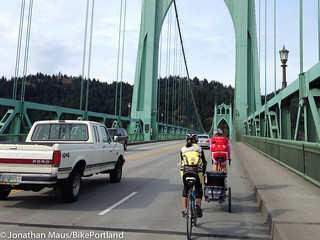(NOTE: ODOT now says biking and walking will be permitted over the bridge, through the construction zone during the closure. Read our full update at the end of this post.)
The Oregon Department of Transportation (ODOT) announced a three week closure of the St. Johns Bridge yesterday. The closure will be in effect every night (seven days a week) from 8:00 pm to 5:00 am starting this Monday (7/29) through August 18th while ODOT crews re-tension the cables that suspend the bridge over the Willamette River. During those times, the bridge will be closed to all users — including bicycle riders and walkers.
In their official announcement, ODOT noted in their headline that “motorists can use the Fremont Bridge” as an alternate route during the closure. ODOT also gave detailed detour instructions to “vehicles” (by which they mean “motorists”). What about people who bike? The only mention was the final sentence in the statement: “Bicyclists and pedestrians may use the Broadway Bridge.”
A quick look at Google Maps confirms that it would take well over one hour for someone on a bike who approaches the St. Johns Bridge only to find out they must about 14 miles south to the Broadway Bridge and then back north to the St. Johns via Highway 30 to cross the river. By contrast, the detour would take someone in a car just over 20 minutes, thanks to the convenient and direct access offered to drivers via N. Lombard, the I-5 Freeway, the I-405 bridge, and Highway 30.
ODOT Region 1 Transit and Active Transportation Liaison Jessica Horning emailed us yesterday asking for help to spread the word about the closure “since the bike/ped detour is a major one.”
Horning also wrote that ODOT is working with their bridge crew to explore options on how to “minimize bike/ped impacts” and that in the meantime they’d appreciate creative solutions for lessening the impact of this work on the bicycle riding public.
In their statement, ODOT says the cable maintenance is necessary because they stretch over time and need to be re-tensioned. “To ensure all cables are tightened equally, travel cannot occur on the bridge during the work.” That sounds reasonable; but we wonder whether bridge crews have kept in mind the weight difference between a person driving a large semi-truck or car versus someone riding a bicycle. It’s worth noting that they are keeping the bridge open to emergency service vehicles during the closures.
The Bicycle Transportation Alliance (BTA) is in touch with ODOT trying to find a solution. We certainly hope something can be done and we’ll keep you posted.
—
A few things about this concern me. First, ODOT shows their auto-centric colors when they issue a press statement about a major detour and assume that it only affects “motorists” (I say that given the placement of “motorist” instructions in the headline and detailed detour instructions versus the dismissive treatment evident in the sentence, “bicyclists may use Broadway Bridge”). Also, the fact that ODOT feels a one-plus hour, 14-mile detour for bicycle riders is acceptable makes it appear that the agency doesn’t fully respect bicycling as a mode of transportation on the same level as driving.
Stay tuned.
UPDATE, 9:59 am: Here’s a statement from BTA Advocate Carl Larson:
“When ODOT puts out notice about a detour, they’re getting better and better at answering the question, “where do people walking and biking go?” Unfortunately, the answer provided for this project (“Bicyclists and pedestrians may use the Broadway Bridge) needed a reality check. Thankfully, ODOT has been receptive to our request for a more realistic detour and, hopefully, a real solution will be offered soon. We hope that our intervention won’t be necessary for future detours. In fact, we have an intern researching work zone policies in other municipalities in an effort to get some better standards in place for our region.”
UPDATE II, 3:47 pm:
Just off the phone with ODOT’s Jessica Horning. They have figured out a plan to allow biking and walking across the bridge during the closure. Horning said this is the first time they’ve done the cable maintenance since the bridge was renovated about 10 years ago. “We had a learning of how much space the boom and scaffolding would take up,” she said. ODOT had to meet a deadline for the traffic advisory, so Horning said their initial statement reflected a “worst case scenario” to meet that deadline. After meeting with bridge project managers this afternoon, they have figured out a path for biking and walking that will remain open. Flaggers will be positioned at either end of the bridge and a path through the construction area will be marked off with traffic cones. “We’ll make every effort to make sure the wait isn’t more than 10 minutes,” Horning added.
People driving cars may use the Fremont Bridge during the closure.


